68 Search Results for focused language stimulation
November 8, 2012
by Carole Zangari -
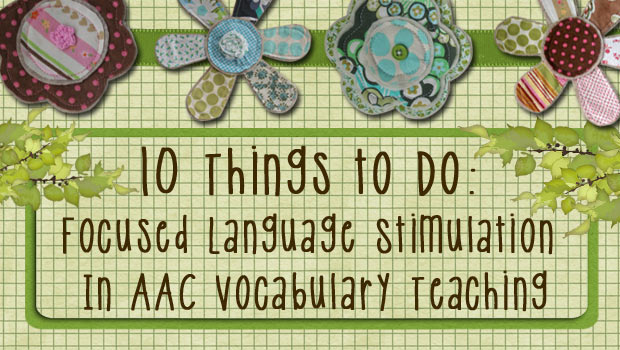
All this month we are talking about considerations in teaching new words to people who use AAC. We’ve talked about the role of focused aided language stimulation and wanted to follow that up with a few more ideas for implementing this strategy. Select the new (target) word to teach giving consideration to Tier 2 words that fit with their language or curriculum goals. Pronounce it. Provide a student-friendly definition Use aided language input: Model the word on the device if it is stored in there OR use the device to explain the new word in a student-friendly way. Find ways to use it throughout the day (and beyond). Hearing the word in various contexts is a great way to deepen the learner’s understanding. Have the AAC learners say it using their AAC (e.g., spelling it out on SGD) or natural speech. Segment it. (E.g., “One of our new words is... [Read More...]
November 7, 2012
by Carole Zangari -
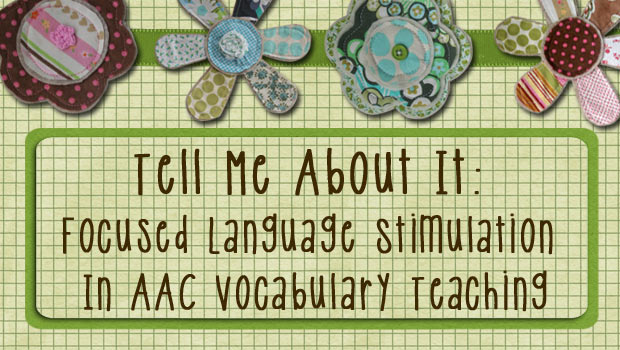
Earlier this month, we introduced a general sequence of how we conceptualize semantic instruction. We promised to elaborate on that. There are two things that I really love about this approach to to vocabulary teaching. The first is that is honors a principle that we know to be true: providing repetition with variety not only helps us reach learners with different strengths, but also gives our AAC learners much-needed practice. The other thing that makes this really work for us is that assessment has an active role but not a central one. Testing takes a backseat to teaching. As we all know, getting accurate assessment information from people who are learning their AAC systems is a huge challenge. Often, our AAC friends don’t have decent test-taking skills so we’re not really testing what we think we’re testing. Just last week I got to see Kristofer, an adorable little fellow who... [Read More...]
March 8, 2021
by Carole Zangari -
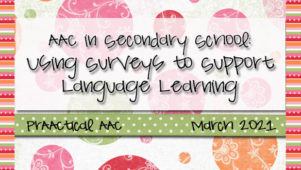
It’s a great day to explore ways to support AAC use, and today AAC SLP Ashley Larisey joins us with some activity suggestions and lots of implementation tips. Ashley is an SLP at Community High School District 218 in Oak Lawn, Illinois. She is also an Adjunct Clinical Supervisor and Instructor at Saint Xavier University. This post, part of the AAC in Secondary School series, focuses on the use of language experience surveys with students who are learning to use AAC. :::::::::::::::::::::::::::::::::::::::::::::::::::::::::::::::::::::::::::::::::::::: Surveys Surveys can be used within almost any classroom activity to provide students with opportunities to communicate with both familiar and non-familiar listeners. Questions that are used for the survey can be used to gather more information about a topic that guides decision-making. Surveys can be embedded into academic, social, vocational, and community-based instruction. Take a look at some examples of how to use surveys in your classroom... [Read More...]
July 6, 2020
by Carole Zangari -
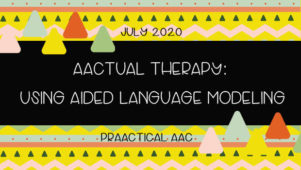
Although we’ve written extensively on the role of modeling in AAC, there are always new perspectives to consider regarding this evidence-based and widely-used strategy. Today, we feature SLPs Kate Grandbois and Amy Wonkka who share their approach to aided language modeling. :::::::::::::::::::::::::::::::::::::::::::::::::::::::::::::::::::::::: Bringing it all Together: Aided Language Modeling Most SLPs working in AAC have come across a variety of different interventions in their practice. Some, like aided language modeling, are popular and commonly seen at conferences. They are the most popular option on the intervention buffet. Others, like discrete trial training, are like the mystery meat – you think you know what it is, you don’t think you’re going to like it, and you’re going to watch while someone else tries it first. Sometimes these teaching procedures are straightforward, and sometimes they are confusing, intimidating, or complicated. You may find that choosing which intervention to use is influenced by... [Read More...]
July 16, 2018
by Carole Zangari -
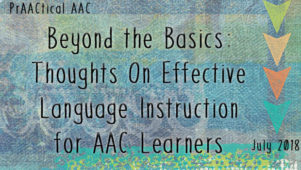
Have you worked with students like these? Gaby has been using SGDs since kindergarten. As she approaches high school, Gaby is able to express many things but her language is significantly below those of her peers. This makes it difficult for Gaby to read grade-level textbooks with comprehension, complete writing assignments, and perform well on academic tests. Ian’s SLP and teacher are trying to understand why he is able to learn new language skills but seems to lose some of them when they start working on new goal areas. When the time came for a speech-language re-evaluation, they were surprised that Ian scored so poorly in areas where he made mastered his IEP goals. Brandon is a fifth grader who wants to go to college someday. His language skills have been growing steadily since he got his first AAC device several years ago, but are still remarkably delayed. In situations... [Read More...]
May 31, 2018
by Carole Zangari -
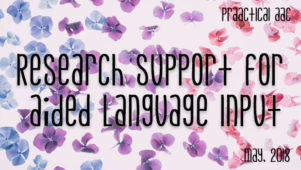
Aided language input, the practice of modeling AAC when speaking to those who are trying to learn AAC, is a pivotal intervention strategy. It has been shown to support comprehension and expression, and the development of early sentence forms. The evidence suggests it may also support the development of certain grammatical morphemes and verb combinations. You can learn more about the implementation of aided language input here. Here are some of the research studies that support the use of this evidence-based practice. Binger, C., & Light, J. (2007). The effect of aided AAC modeling on the expression of multi-symbol messages by preschoolers who use AAC. Augmentative and Alternative Communication, 23, 30–43. Binger, C., Maguire-Marshall, M., & Kent-Walsh, J. (2011). Using aided AAC models, recasts and contrastive targets to teach grammatical morphemes to children who use AAC. Journal of Speech, Language and Hearing Research, 54, 160–176. Dada, S., & Alant, E. (2009). The... [Read More...]
March 8, 2018
by Carole Zangari -
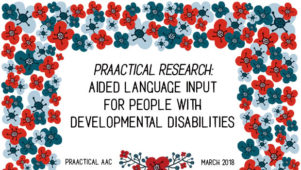
We’re pleased to welcome back Dr. Kathy Howery for another analysis of an AAC research article. Kathy is based in Alberta, Canada, and has worked in the field of AT and special education for over three decades. In the past year, she completed her doctoral studies where she used phenomenological methods to seek to understand the lived experience of speaking with/through a speech generating device. Kathy is currently working as a consultant to schools and school districts across Alberta focusing primarily on children and youth with complex communication needs. ::::::::::::::::::::::::::::::::::::::::::::::::::::::; Allen, A. A., Schlosser, R. W., Brock, K. L., & Shane, H. C. (2017). The effectiveness of aided augmented input techniques for persons with developmental disabilities: A systematic review. Augmentative and Alternative Communication, 33, 149-159. What this Article is All About (The Focus of the Research) This article presents the results of a systematic review of the research into what the authors refer... [Read More...]
October 26, 2017
by Carole Zangari -
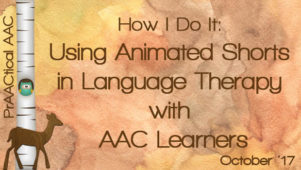
Looking for ways to engage AAC learners in language therapy? Today, we welcome back SLP Rachel Madel to tell us about her experience in using wordless videos. Her prAACtical tips will get you excited about using videos like these, curated by The Activity Tailor, in your lessons. Enjoy! ::::::::::::::::::::::::::::::::::::::::::::::::::::::::::::::::::::::::::::::: Using Animated Shorts to Build Language Skills with AAC Learners We are living in a digital age, where video content is often free and easy to access. Children on my caseload are tech savvy and are constantly dazzling me with how well they can navigate YouTube to find their favorite videos. Motivation is paramount in creating meaningful communication interactions and watching animated videos is highly motivating for both students and clinicians. I’ve had great success utilizing wordless videos in my practice and was lucky enough to present on the topic during “AAC After Work” with a fellow AAC colleague, Susan Berkowitz. In case... [Read More...]
October 27, 2016
by Carole Zangari -
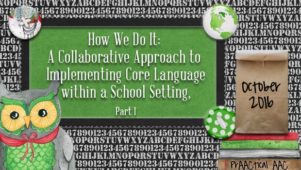
Nothing makes us smile like seeing teams in which professionals serving students with AAC needs work together to ensure that those students can use and grow their language skills. In this guest post, we learn about an approach that has worked for one such team, Lori Sanzeri and Chelsea Collins. Lori Sanzeri, MA CCC-SLP, TSHH, received her B.S. in Speech Language Pathology from SUNY Cortland in 2003 and M.A. from St. John’s University in 2009. She has worked for the NYC Department of Education since 2003 and teaches AAC and phonetics at St. John’s University. Chelsea Collins, MS CCC-SLP, TSSLD, received her B.S. in Special Education from Seton Hall University in 2009 and M.S. in Communicative Sciences and Disorders from New York University in 2012. She has worked for the NYC DOE since 2012 and specializes in AAC and early intervention. They are on Instagram as @thelanguageladies and have a Facebook page as... [Read More...]
December 7, 2015
by Carole Zangari -
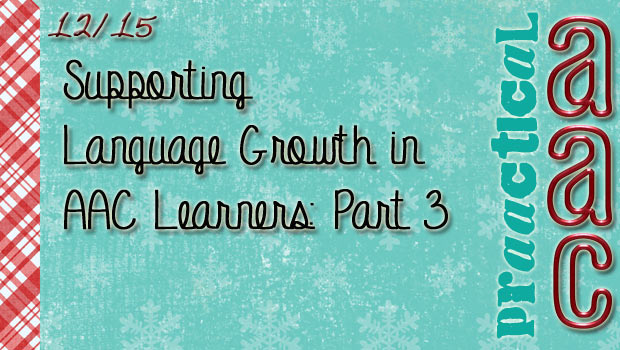
In some earlier posts, we looked at conversations with AAC learners who communicate with single words or short utterances, and began thinking about ways to stretch their language learning. In this post, we’ll continue to explore ways in which our intervention can facilitate language growth. Let’s start with an example of a typical conversation between an AAC learner and his/her therapist. Activity: Book reading [with aided language input] SLP: Look at all these animals! [Expectant pause] Marcus: Bird. SLP: Yes, lots of birds there. Those are seagulls. What else do you see? Marcus: Fish. SLP: It looks like a fish. That’s a dolphin. Dolphins are mammals. Remember from Ms. Louis’s class when you read Day of the Dolphins? Marcus: Swim SLP: Yes, they are really good swimmers. From the standpoint of shared meaning, this conversation has some good features. But even just reading the dialogue online, I bet you... [Read More...]









